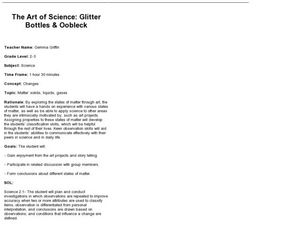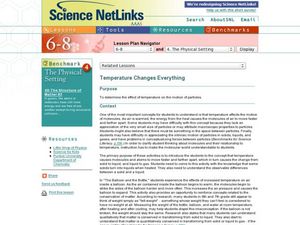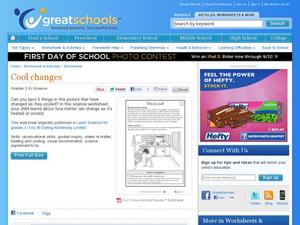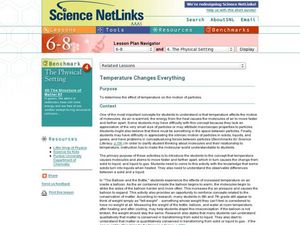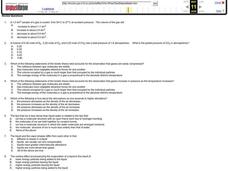Curated OER
The Art of Science: Glitter Bottles and Oobleck
After having a class discussion on the three states of matter, young scientists utilize the wonderful substance, Oobleck in order to experience something that changes states of matter. They also create "sparkle jars" which...
Curated OER
States of Matter
Properties in measurement, pressure and viscosity of solids, liquids, and gases are the main topics covered in this slideshow. The explanations of Pascal's, Bernoulli's, and the Venturi effects are very clear. Easy to understand diagrams...
Curated OER
The Four States of Matter
The concise slides in this presentation give a good amount of detail for many aspects of matter chemistry. There are summaries and diagrams for particle movement in solids, liquids, gases and plasma.
Mr. E. Science
Changes in Matter
Do solids, liquids, and gases even matter? The presentation focuses on changes in matter, including phases, Boyle's Law, Charles' Law, and physical changes.
Curated OER
Temperature Changes Everything
Learners determine the effect of temperature on the motion of particles. They study the difference between particles in a gas, liquid, and a solid and see how the characteristics of solids, liquids, and gases can be explained by particle...
Curated OER
Water and Ice
Students investigate how water goes from a solid to a liquid then back again. In this experimental lesson students conduct their own experiment and see how water changes form.
Curated OER
Keep the Wet Out
After reading a short paragraph about certain materials and their ability to repel water, learners answer two questions regarding a variety of materials' ability to repel water. There are six different substances placed in bowls of...
Curated OER
This is Cool!
Third and fourth graders who are studying states of matter will enjoy this simple exercise. In it, they look at a picture of a girl in her kitchen, and they must circle five examples of materials that have changed states of matter as...
Curated OER
Dance Showing Science Contexts of Movement: States of Matter
Fifth graders dance in different ways to show movement of states of matter. In this matter lesson plan, 5th graders make connected shapes with a partner, make flowing movements, travel rapidly, and more.
Curated OER
Buoyancy
This is a brief survey of the states and properties of matter directed toward upper elementary physical scientists. Solids and liquids are compared. Density and buoyancy are related. Use this presentation just prior to demonstrating...
Curated OER
Temperature Changes Everything
Middle school chemists visit interactive websites in order to discover what happens to molecular motion when heat is added to matter. They conduct an experiment that demonstrates the expansion of matter with the addition of heat. A lab...
Curated OER
Putting the Ice in Hockey
Eighth grade physical science classes examine why the ice on which hockey is played is slippery. They do so by discussing phases of matter and the molecular motion in each. They read an article on a website and write out answers to 10...
Curated OER
Strong Ice
Through three activities, first-time physical scientists wonder at the properties of water. Freeze some soda cans and a container of water prior to the investigation to show that water expands when frozen. Lab groups experiement with...
Curated OER
Snow Sculpture
Third graders discuss and demonstrate how water has three forms: solid, liquid, and gas. They create a snow figure outdoors or freeze ice in molds and predict how long it will take for real solid water (snow sculpture or ice) to become...
Curated OER
Sometimes, solid + liquid = gas
Third graders experiment with common household liquids and solids. In this chemical reaction lesson, 3rd graders discuss phase changes and experiment to find other ways to create gases. They use water, vinegar, lemon juice, flour, baking...
Curated OER
Physical Changes and the Water Cycle - Three
Third graders observe and reproduce the water cycle in their very own classroom. A simple, yet very effective, demonstration on how water evaporates is observed by the young scientists. They make observations and sketches in their...
Curated OER
Liquid Volume and Mass Word Problem
Jeff, Steven, and Donna are ordering juice, and it's up to your scholars to determine how many liters they get all together. There is a visual to help scholars add up these amounts, and everyone orders in single-digit liters. There is an...
Curated OER
Cool Liquids
Chemistry neophytes use a temperature probe to assess the change as five different liquids evaporate. The implantation section suggests that they take readings every five seconds for a total of four minutes. They graph the data, look up...
Curated OER
Phases of Matter
Students are introduced to the basic states of matter: solids, liquids and gases. Through experimentation, students determine that liquids and solids have definite volume, that gases do not have definite volume, and that solids have a...
Curated OER
Sugar in Tea
Little chemists address whether or not you can get sugar back out of tea after it has dissolved. The PowerPoint itself simply walks them through the questioning process, considering different possibilities. The final slide settles on...
Curated OER
Phases of Matter
For this matter worksheet, students calculate volume and partial pressure for gases, compare liquid and vapor phases, and review the characteristics properties of gases. This worksheet has 12 multiple choice and 3 problems to solve.
Curated OER
Water Changes and Moves
Pupils explore the three forms of water and observe how it changes from a solid to a liquid to a gas. The concepts of condensation, evaporation and the introduction to the water cycle form the basis of this instructional activity.
Curated OER
Is it a solid or liquid?
Learners review the vocabulary terms solid and liquid. They also review that adjectives tell what kind, which one, and how many. The teacher introduces a "Oobleck" after reading "Bartholomew and the Oobleck" by Dr. Seuss. The students...
Curated OER
A Chemist in My Class?
First graders in kindergarten science class discuss matter. They make predictions and then identify mystery items in brown paper bags as either solid, liquid, or gas by using their senses. They discuss that a chemist is a scientist that...


